In audio production and broadcasting, cueing refers to the process of preparing a sound source for playback. This includes positioning the sound source at the appropriate point, adjusting level and equalization settings, and ensuring all other settings are properly configured. The act of cueing up a sound source is to make sure that it is in the correct position and that the settings are ready for playback.

What is Cueing: Table of Contents
Cueing is a crucial aspect of music production that involves preparing a sound source for playback. In the context of music production, this process includes positioning the sound source at the appropriate point, adjusting level and equalization settings, and ensuring that all other settings are properly configured. The goal of cueing is to make sure that each sound source is in the correct position and that the settings are ready for playback. This ensures that the final mix is of the highest quality possible.
What is Cueing in Music Production?
At its core, cueing in music production is the act of preparing a sound source for playback. This involves a number of different elements, including:
- Positioning the sound source: Before you can play back a sound source, you need to make sure it’s in the right place. This might involve setting the playback point on a track or positioning a microphone for recording.
- Adjusting levels: Once you’ve positioned the sound source, you need to adjust the level settings to make sure the sound is at the appropriate volume. This might involve adjusting the gain on a microphone, or setting the fader level on a mixing board.
- Adjusting equalization: In addition to adjusting levels, you may also need to adjust the equalization settings to get the sound you’re looking for. This might involve adjusting the bass and treble levels on a track or using a graphic equalizer to fine-tune the sound.
- Configuring other settings: Finally, you’ll need to ensure that all other settings are properly configured for the sound source you’re cueing up. This might include selecting the appropriate recording format, setting the sample rate and bit depth, or configuring any effects or plugins that you plan to use.
The Role of Cueing in Music Production
Now that we’ve defined what cueing is, let’s explore why it’s so important in the context of music production.
First and foremost, cueing is critical for achieving high-quality audio output. By carefully preparing each sound source for playback, you can ensure that the final mix sounds as good as possible. This is especially important when you’re working with multiple tracks or sources, as any errors or issues in one source can impact the overall mix.
Cueing is also important for ensuring that sounds are properly synchronized. When you’re working with multiple tracks or sources, it’s essential to make sure that everything is timed correctly so that the sounds blend together seamlessly. By cueing up each sound source properly, you can help ensure that the final mix sounds as cohesive as possible.
Finally, cueing is important for ensuring that levels are balanced. By carefully adjusting the levels of each sound source, you can prevent any one source from overpowering the others and create a well-balanced mix. This is particularly important when you’re working with vocals or other lead instruments, as you want these sounds to be prominent without overshadowing everything else.
Techniques for Cueing in Music Production
So, how can you improve your cueing skills in music production? Here are some practical techniques and tips to get you started:
- Use specialized monitoring circuits: Many mixing boards and other audio equipment come equipped with specialized monitoring circuits that can be used for cueing up sounds. These circuits are separate from the main mixing buses and are only audible to the mixing engineer, so you can adjust levels and other settings without impacting the overall mix.
- Use pre-fader solo (PFL) features: Another technique for cueing up sounds is to use the pre-fader solo (PFL) feature on a mixer. PFL allows you to listen to a particular sound source without affecting the levels of other sources in the mix. This is a useful technique for fine-tuning the settings of a particular sound source before bringing it into the mix.
- Use headphones: When cueing up sounds, it’s often helpful to use headphones to get a better sense of the sound quality and level balance. Headphones allow you to hear the sound in greater detail and can help you identify any issues or areas that need improvement.
- Take breaks: When working on a complex mix, it’s important to take breaks and step away from the project periodically. This can help you maintain perspective and avoid getting too caught up in the details. When you come back to the mix, you’ll be able to approach it with fresh ears and a clearer sense of what needs to be done.
- Listen to other mixes: Listening to other mixes can be a great way to improve your cueing skills. Pay attention to how other engineers position sounds, adjust levels, and use equalization to achieve different effects. By studying other mixes, you can gain a better understanding of the techniques and principles that go into cueing up sounds.

